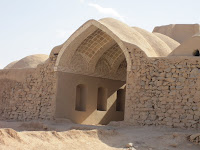Zoroastrian Fire Temple
We visited a relatively modern Fire Temple in Yazd dating from 1940, but, according to tradition, the flame of this temple has been burning since 1174 in various places in Iran. Only the priests are allowed behind the glass through which we saw the flame.
You can see the Zoroastrian symbol above the door. A bird-man holds a ring which symbolizes loyalty in one hand, with the other hand held up as a sign of respect. The three layers of feathers in the wings represent the belief that you should think, speak, and act decently.
Towers of Silence
 Up until the 1960s when the city of Yazd started to encroach on the Towers of Silence, the Zoroastrian population of the city carried their dead up to the Towers of Silence in a solemn procession led by a priest, carefully set the body on a large stone slab and left it there to be eaten by the vultures. Because they believed in the purity of the elements (water, earth, air, and fire) they didn’t believe in burying or burning the bodies for fear of tainting the earth or polluting the air.
Up until the 1960s when the city of Yazd started to encroach on the Towers of Silence, the Zoroastrian population of the city carried their dead up to the Towers of Silence in a solemn procession led by a priest, carefully set the body on a large stone slab and left it there to be eaten by the vultures. Because they believed in the purity of the elements (water, earth, air, and fire) they didn’t believe in burying or burning the bodies for fear of tainting the earth or polluting the air.It was a bleak and sorrowful place and the elderly man with his donkey did nothing to dispel the mood.










No comments:
Post a Comment